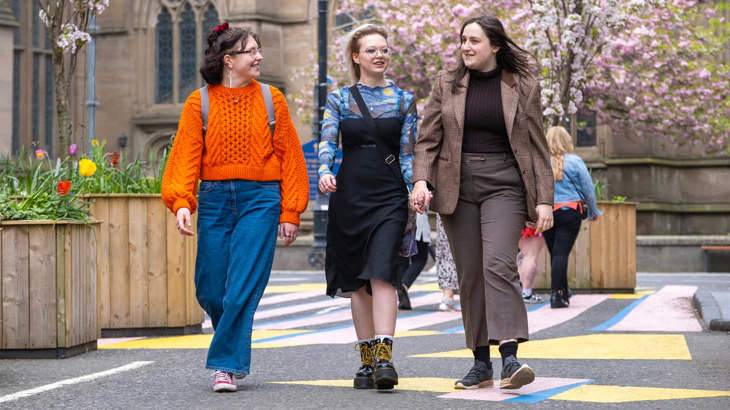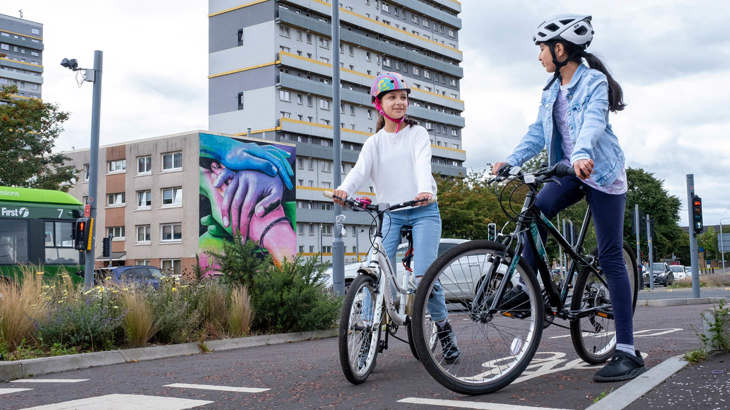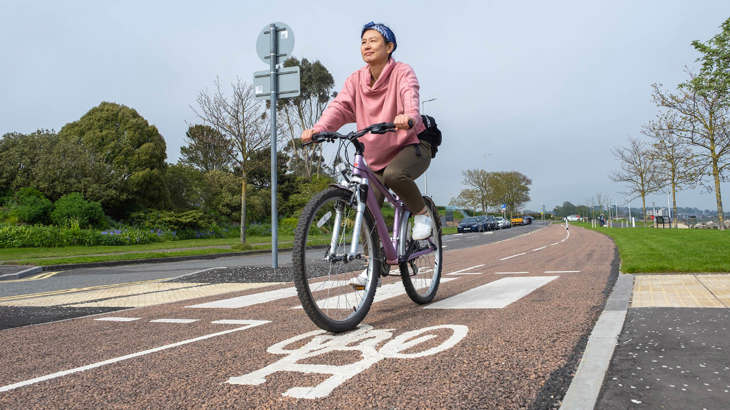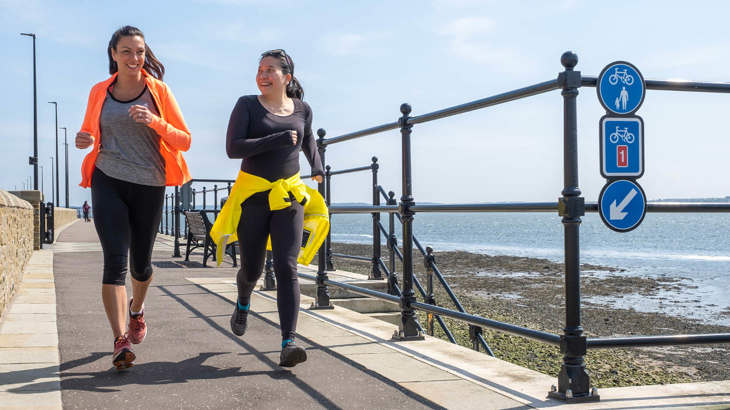Women make up 51% of the UK population, but their travel behaviours are often overlooked in transport planning. Tiffany Lam, our Strategy Lead for Equality, Diversity and Inclusion, explores the role of gender budgeting in overcoming this problem and helping deliver more inclusive routes for everyone.

Gender budgeting can help create more inclusive transport systems and places ©McAteer Photography/Sustrans
The challenge
Our transport systems prioritise commuting journeys to and from city or business centres.
This reflects a male bias because men tend to make more of these journeys, whereas women tend to make more local trips related to household and caring responsibilities.
Women’s trips also tend to be more encumbered and involve multiple stops.
What is gender budgeting?
Gender budgeting, the analysis of budgets from a gender lens, is a practical tool to help us create more inclusive transport systems.
Gender budgeting makes explicit who benefits from public spending and at whose expense.
It does this by considering the different impacts of budgets on different groups of people based on gender and other factors like age, disability and income.
That’s why putting this analysis into practice promotes a fairer distribution of public resources.
Working with the Scottish Women’s Budget Group, Sustrans has explored how gender budgeting could be applied to active travel investment in Scotland.

By taking a gender budgeting approach, public resources are distributed more equitably ©McAteer Photography/Sustrans
Why gender budgeting in active travel?
10% of Scotland’s transport budget (£320 million) has been committed for active travel by 2024/25, representing an uplift in active travel investment.
One of the strategic objectives of Transport Scotland’s Active Travel Framework is to reduce inequalities.
Gender budgeting can help translate this commitment into reality.
It can help ensure that this investment is distributed fairly and does not entrench existing gender, or other, inequalities.
For example, the Sustrans Walking and Cycling Index found that men in Scotland are over twice as likely (29%) as women (13%) to cycle at least once a week.
Men in Scotland are also more likely to think cycling is safe than women (45% vs 39%).
Adopting a gender budgeting approach to active travel investment can help us ask the right questions and consider the gender equality implications of funding commitments.

Gender budgeting helps us to ask the right questions before projects are delivered ©McAteer Photography/Sustrans
How can we apply a gender budgeting approach?
Consider cycling infrastructure investment.
Rather than treating it as a universal good that everyone will benefit from, a gender budgeting lens would prompt the following questions:
- What proportion of the budget has been allocated for physical infrastructure (eg cycle lanes) vs. social infrastructure (eg education, outreach, behaviour change), which is needed to get more diverse groups of people (eg women, disabled people, people of colour, people with low incomes) cycling?
- What is the balance between physical infrastructure that facilitates movement (eg cycle lanes) vs. infrastructure that facilitates stillness (eg cycle parking, benches)?
- What types of journeys will physical infrastructure facilitate (eg work commutes, care journeys, leisure trips)?
- What type of social infrastructure – community support and engagement programmes – will accompany new physical infrastructure, and what measures will be taken to ensure that it will reach those who would benefit the most?
- What types of jobs will this cycling infrastructure investment generate? Who will benefit from this job creation? This means taking a deeper look at the sectors in which new jobs will be created, including the gender split across these.
- Are adequate resources allocated towards ensuring women’s and girls’ safety? For example, have physical measures like lighting been planned for, alongside conducting gender safety audits or Equality Impact Assessments

Monitoring and learning from the impact of projects also has a key role to play in creating more inclusive connections ©McAteer Photography/Sustrans
How can we monitor the impact of gender budgeting?
Understanding, monitoring and evaluating the gender impacts of active travel investments requires asking the right questions and developing appropriate indicators to measure gender inclusion.
This requires “Intersectional data.”
Intersectional data aims to connect and present the way multiple facets of an individual's identity interact.
For example, the overall impact on a person’s individual experience if they are a woman, are also from a minority ethnic background, and if they experience a physical disability.
Collecting intersectional data isn’t a widespread practice, which is a barrier to gender budgeting.
But at a minimum, it is important to collect sex-disaggregated data and analyse it so that it feeds into budgeting and evaluation processes.

Working with Scottish Women's Budget Group, Sustrans have put together 9 recommendations for gender budgeting in active travel ©McAteer Photography/Sustrans
Looking forward: Our recommendations for implementing gender budgeting
Our research developed nine recommendations for Transport Scotland, Sustrans, local authorities and community organisations to work towards implementing gender budgeting in future active travel investments:
- Establish an explicit gender equality goal to promote equality of outcomes.
- Require funding applicants to address how their project will contribute to this gender equality goal.
- Develop gender expertise, through access to training or toolkits, and support community groups and local authorities applying for funding to do the same.
- Use the framework for gender budgeting in active travel investment.
- Collect and analyse intersectional data, or data that identifies inequalities within and between groups of people based on the way multiple aspects of identity intersect.
- Embed Equality Impact Assessments, gender safety audits and accessibility audits in design and decision-making processes.
- Partner with community organisations to do meaningful engagement with local people.
- Work towards diversifying the team and making decisions about funding allocation. At a minimum, require funding applicants to develop a strategy to ensure that diverse perspectives are considered in active travel projects.
- Fund both physical and social infrastructure for cycling.
Read Sustrans and Scottish Women’s Budget Group report on gender budgeting in active travel and the evaluation framework.





